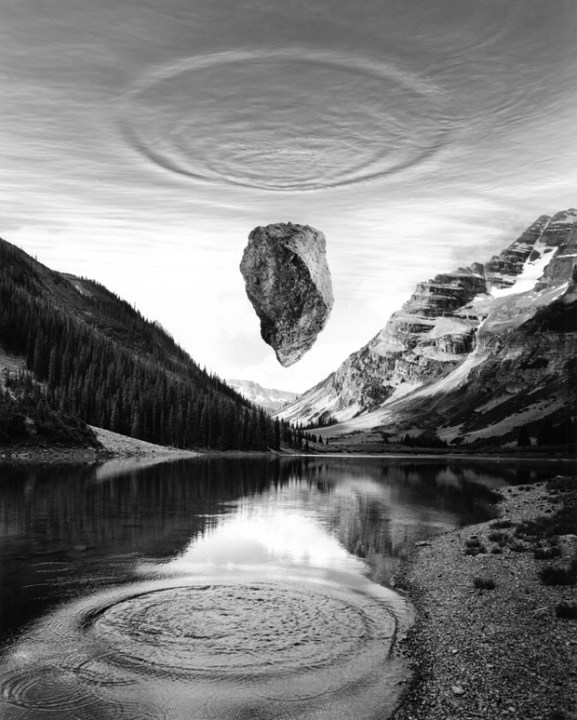An untitled photograph by Jerry Uelsmann from 1991 shows a rock like Magritte’s floating in the sky between an Ansel Adams mountainside of conifers on one side and a bare mountain on the other; concentric ripples on a lake in the foreground are mirrored in the sky above. It will, I fear, remind readers of that BBC2 ident with Zen-ish sky-ripples.
Each of Uelsmann’s photographs, always in black and white, is composed from three or five negatives meticulously aligned to make a single composite print. Naked female bodies float above water or clouds; anonymous silhouetted male figures observe from doorways; cupped hands grow from a tree stump. The connotations are surreal and Gurdjieffian. ‘One does not photograph something for what it is, but for what else it is,’ he said in the days when he still took pictures of ‘reality’.
Born in Detroit in 1934, Uelsmann was given an academic post in 1960 at the University of Florida, the state where he still lives, in a plate-glass house surrounded by trees, with a giant rabbit sculpture on the lawn. Ansel Adams invited him to lecture at West Coast workshops for 15 years, even though he had reservations about images that weren’t ‘whole-clothed’ in reality.
It is hard to object in theory to montage, since it dates from the cradle-days of photography. In the 1850s Oscar Gustave Rejlander, from whom a side of Uelsmann’s ancestry is clear, took up ‘combination-printing’, causing a sensation with his large-scale ‘Two Ways of Life’, with its semi-clothed models. Prince Albert bought three versions.
But there was something of the taxidermy squirrels’ tea-party in the Victorian penchant for manipulating photographs. In 1866 Alexandra, then Princess of Wales, began arranging photographic collages of Bertie and the children in drawing-rooms painted on pages of her album. In ‘Memories of Max Ernst’ (1997), Uelsmann shows hands holding open a Victorian album with one sitter’s head replaced by an eyeball.

Uelsmann also mounted seeing eyes on to the palms of hands in ‘Homage to Herbert Bayer’ (2004), against a mountain and mottled sky. Bayer’s own photomontage from 1932 called ‘The Lonely Metropolitan’, uses a background of apartment blocks for the eyes-in-palms. Actually, I think most people today will be reminded of the Pale Man, seeing by means of a similar eye-palm arrangement in Guillermo del Toro’s film Pan’s Labyrinth (2006). Del Toro combined animatronics and computer-generated imagery. Uelsmann perseveres with his traditional darkroom printing. A teenager with Photoshop can do it all quicker, if not with the artistic intent.
Uelsmann Untitled presents a couple of hundred prints, glossily printed in a quarto format, with only a few duds (such as untitled, 2008, of a nymph floating over the Grand Canal), with an annoyingly art-speaky essay called ‘Primal Scene’ by Carol McCusker, the curator of photography at Florida. I don’t know. Uelsmann’s whole oeuvre could be seen as a tragic dead end, as he could have effected similar mystical insights through straight photography — think of Kertész’s celebrated snatched scene at Meudon or the contemplative qualities of the best of Edwin Smith.
Available from the Spectator Bookshop, £32.95 Tel: 08430 600033







Comments